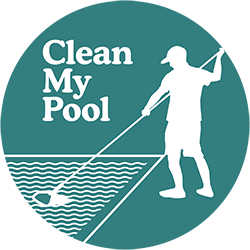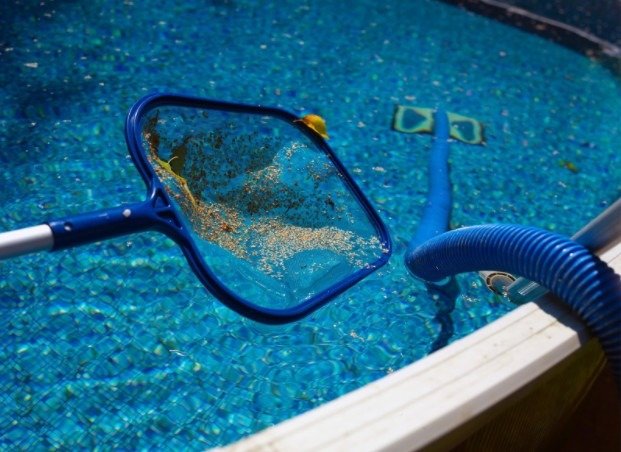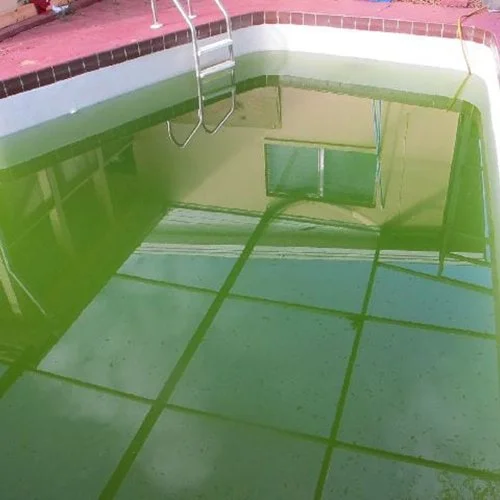Why Is My Pool Green and How do I fix it?
Why do Pools turn Green?
There are a number of reasons why the water in your swimming pool would turn green, the most common of which is algae blooms which frequently happen when the level of chlorine in the water is too low. Other causes for a green pool include high levels of dissolved metals, phosphates, frequent rain, over stabilized water, high pH levels, bad filtration, and pollen.
Common Causes for a Green Pool
A lack of Chlorine
Low chlorine is the most common reason why pool water goes green. Without chlorine in the water, algae blooms can easily turn your whole pool green within a day. This is particularly true in the warmer months of the year.
On average your pool’s free chlorine level should be between two and four parts per million. However, if it’s not at this level, add more chlorine until it is in this range. This will keep your pool algae-free in the future.
Too Much Cyanuric Acid or Over-Stabilized Water
Cyanuric acid (CYA) is a water conditioner that prevents chlorine from degrading in sunlight. You can think of it as sunscreen for your swimming pool. High levels of CYA in your pool inhibit the chlorine from sanitizing the water. This leaves your pool vulnerable to algae growth.
The correct level of CYA in your swimming pool should be between 30 - 50 parts per million. If your level is higher, the only way to correct it is to partially drain your pool and refill it with untreated water.
To prevent high levels of CYA in the future, you may want to consider switching from chlorine floaters or tablets which contain cyanuric acid, to using chlorine as a standalone product. Alternatively, converting your pool to saltwater with a chlorinator will also solve this problem and prevent the problem from ever occurring again.
High pH Level
When pool water reaches a pH level of 8.2 or higher, the chlorine in the water becomes completely inactive. High pH levels are most common in saltwater pools that make use of a chlorinator.
It’s important to regularly test the pH of your pool to ensure that the level is within the range of 7.4 - 7.6. If the pH level is higher than needed, you can lower it by adding pool acid to the water.
High Phosphate Level
The most common way that phosphates can find their way into your pool is through organic debris, detergents and garden runoff such as fertilizer. Phosphates increase the growth rate of algae, this causes the free chlorine in your pool to be used up quicker. This process will cause the chlorine demand of your pool to rise if not treated.
If the phosphate level of your pool is above 500 parts per billion, add a phosphate remover to lower it.
Not Enough Filtration
On average your pool filter should run for at least 8 hours per day during the warmer months of the year. If the pool water is not adequately filtered, a build-up of organic debris in the water can occur which can cause your pool to go green.
Pollen
Pollen produced by plants surrounding the pool area or carried on the wind can end up in your pool turning the water green. Pollen is often too small to be filtered out by standard pool filters, this means that pollen can build up in the water throughout the year.
As pollen builds up in the water and begins to settle on the surfaces of the pool, it can be mistaken for algae. If left uncleaned, pollen can increase the level of phosphates in your pool water which eventually will turn all of the water in your pool green.
Fortunately, pollen is harmless and will have no ill effects on you or your swimming pool.
Dissolved Metals
There are two ways in which metals, most usually copper, can be introduced into your pool. The first is through water source, for instance, if you make use of mineral-rich water, often present in borehole water, to fill your pool. The other way is through the oxidation of metal pool accessories, such as metal ladders, fitting or heating systems. This oxidation occurs when the acid level of the water is high, as is the case when doing a shock treatment.
If left untreated, the problem of dissolved metals will continue to worsen, causing stains on the fit and finish of your pool. Excess metals can easily be removed from the pool water using metal remover products.
Frequent Rain
Rain in itself is not bad for your pool and some pool chemicals such as cyanuric acid and calcium benefit from being diluted. However, frequent rain and the natural acidity of rainwater, with an average pH of 5, can raise the pH level and dilute the amount of chlorine in your pool water. If this wasn’t enough, rain is also known to carry organic particles such as plant matter. What this means is that high levels of rain vastly increase the chances of your pool turning green.
Is it Safe to Swim in a Green Water Pool?
Short answer – No.
Water that is rich in algae is home to many different varies of bacteria, insect larva and parasites. These microscopic organisms can enter the body through the nose, ears, mouth, eyes and cuts in the skin, often causing harmful consequences when they do. This makes swimming in a green pool not worth the risk.
How to Troubleshoot the Cause of Green Pool Water
When troubleshooting the reason your pool is green, the first thing to do is look at the pool itself. Each different cause for green pool water has a subtle difference in how it makes the water look.
Algae
Algae first starts to grow on the walls and bottom of the pool first. Dark green in colour and slimy to the touch, algae is hard to remove from pool surfaces unless vigorously scrubbed. As the Algae bloom becomes worse, the water of the pool will be a consistent dark green colour and be swampy in appearance, this will make it impossible to see more than a few centimetres into the water.
Pollen
Like algae, pollen will first become visible on the bottom of the pool, and it is for this reason, that it is often mistaken for mustard algae. But unlike algae, pollen will not cling to the bottom of the pool and will dissipate into a cloud with any movement in its vicinity.
Dissolved Metals
Pools affected by dissolved metals turn a light green colour, almost as if someone has added food colouring to the water. Despite the green colour of the pool water, visibility in the pool will still be fairly clear, with the bottom of the pool being easily visible.
High levels of dissolved metals most often oxidize right after a shock treatment has occurred. So if you find that your clear pool has turned green shortly after adding pool shock to the water, metals are the most likely the cause for your green pool water. Pools with high levels of metal in the water often develop green stains on the surfaces of the pool. These stains are very resistant to being scrubbed off.
If you are having trouble diagnosing the cause of your green pool, consult an expert. Be sure to let them know the state of your pool and the condition of the water. Photos of your pool can be very helpful in this situation.
How to Fix a Green Pool
Getting Rid of Algae In Pool Water
Before you start:
Test and balance the water
Learn how to test and balance your swimming pool
Open up and check your filter
If it’s clean, great. If not, clean it out.
Clean the Pool
Remove all debris such as leaves and twigs from the pool and empty the weir basket.
Scrub all of the Pool Surfaces
Give the pool floors, walls, and steps a good, hard scrub. This will loosen all of the algae that is clinging to the surface of the pool, By doing this you increase the effectiveness of the Green to Blue treatment.
Lower your Swimming Pool’s pH
For algae to thrive in your pool, the pH level of your water must be well above 7.6. To prevent the algae from reproducing, you need to lower the pH of your water to between 7.2 - 7.6.
Shock the Pool
Pool shock is essentially a high dosage of chlorine that sanitizes your water and kills the algae at the root. The amount of shock needed to treat your pool water is determined by the severity of your algae problem:
Teal - 1 Bag
Light Green - 2 Bags
Dark Green - 3 Bags
Black - 4 Bags
Add Flocculant
Flocculant or Floc is a binding agent that causes small particles in the water such as algae to bond together causing clumps. Once heavy enough, these clumps then settle on the bottom of your pool, ready to be vacuumed out.
To Floc, your swimming pool first set your pump to "Recirculate' or 'Recycle'. This will help mix the floc throughout your pool while stopping the water from flowing through your filter.
Make sure when adding flocculant to your pool that you use the correct amount for the size of your swimming pool. If you are unsure of the size of your pool, please see our Pool Volume Calculator to work out the litre capacity of your pool.
Once the floc has been added, allow the water to circulate for at least 8 hrs to make sure the flocculant is fully mixed in, then shut off your pump and allow your pool to sit for 24 - 36hrs. During this time the flocculant will bind the particles together and settle them on the bottom of the pool. You’ll notice a particle cloud forming on the bottom of your pool as this happens.
Important Note: Before you proceed to the next step, please ensure that the water level of your pool is ¾ of the weir. If you need to add more water, you can do so while the flocculant is working, as the extra water will not have an effect on its effectiveness.
Vacuum the Pool
Attach a manual vacuum cleaner to the multiport of your filter and set the multiport valve to Waste. It’s important to do so as you do not want the algae to go into your filter.
Slowly move the vacuum across the bottom of the pool, making to sure to remove as much of the algae as possible. If too much debris kicks up and water becomes too cloudy to see what you’re doing, switch off the pump for a few hours and allow to it to resettle before continuing. You may have to do this several times, depending on how much debris you need to vacuum. During the vacuuming process you may need to top up the water to your pool, so please be aware of your water level.
Add an Algaecide
Once you’re done vacuuming we recommend shocking your pool again to ensure all the algae is gone before adding an algaecide to prevent any further algae growth from taking place.
Clean or Replace Your Filter Media
It’s always important to clean your pool filter after an algae bloom. Algae deposits and spores are often recirculated back into your pool through a dirty filter. This is one of the most common errors pool owners make when fixing a green pool.
Balance your Pool Water, add Clarifiers and Reset your Pool Pump
This will bring back the sparkle to your pool again and remove the last remnants of particles in your pool.
Getting Rid of Pollen In Pool Water
Getting rid of pollen in your pool can be tricky as the particles are too small to be caught by the pool filter. There are however two ways to rid your pool of pollen: the first is a skimmer sock. The sock is placed over the weir basket and catches the fine pollen particles suspended in the water as water is circulated through the pool. The sock will need to be frequently changed in order to be effective. The second method is to use flocculant in the same manner as removing algae from your pool.
Getting Rid of Metals In Pool Water
To remove dissolved metals from your pool will require a sequestrant. Sequestrants are essentially flocculant for metal particles, they cause the metals to clump together which makes it easier for the pool’s filter to remove them out.
After the sequestrants have done their job and the pool is clear again, you now need to remove the trapped metals from your filter. While a simple backwash will remove most of them, it’s best to chemically clean the filter to ensure that all of the trapped metals are removed from the pool.
After all of the metals have been removed from the pool, you should then try to pinpoint how the metals got into the water in the first place.
If metals are entering the pool from the source water such as borehole water, you should consider adding sequestrants to your pool weekly to help filter them out on a regular basis.
If you have any more questions about how to treat a Green Pool, or any other water care issue, contact us for an obligation free quote.










